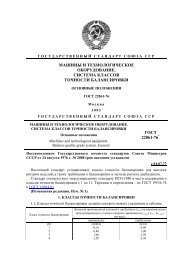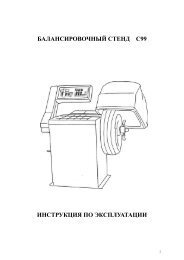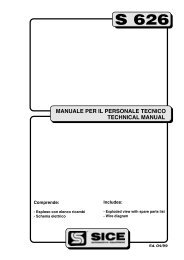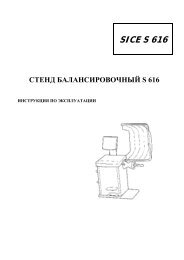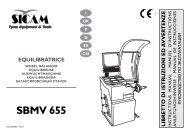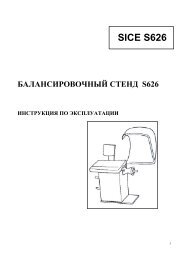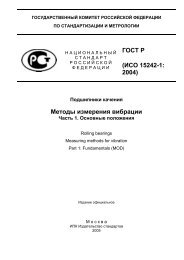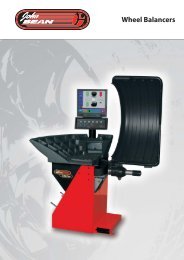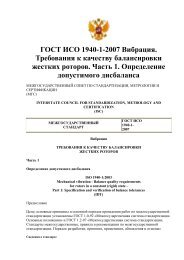Garrett Catalog - RB Racing
Garrett Catalog - RB Racing
Garrett Catalog - RB Racing
Create successful ePaper yourself
Turn your PDF publications into a flip-book with our unique Google optimized e-Paper software.
<strong>Garrett</strong> ®<br />
by Honeywell<br />
Turbo Selection - Gas<br />
This article is more involved and will describe parts of the<br />
compressor map, how to estimate pressure ratio and mass flow<br />
rate for your engine as well as how to plot the points on the maps to<br />
help choose the right turbocharger. Have your calculator handy!<br />
Parts of the Compressor Map<br />
The compressor map is a graph that describes a particular compressor’s<br />
performance characteristics, including efficiency, mass<br />
flow range, boost pressure capability, and turbo speed. Shown below<br />
is a figure that identifies aspects of a typical compressor map:<br />
Pressure Ratio<br />
Pressure Ratio ( ) is defined as the Absolute outlet pressure<br />
divided by the Absolute Inlet Pressure.<br />
Where:<br />
= Pressure Ratio<br />
P1c = Compressor Inlet<br />
Pressure<br />
P2c = Compressor Discharge<br />
Pressure<br />
It is important to use<br />
units of Absolute Pressure<br />
for both P1c and<br />
P2c. Remember that<br />
Absolute Pressure at<br />
sea level is 14.7 psia (in<br />
units of psia, the “a” refers<br />
to “absolute”). This<br />
is referred to as standard<br />
atmospheric pressure at<br />
standard conditions.<br />
Gauge Pressure (in<br />
units of psig, the g refers<br />
to “gauge”) measures the pressure above atmospheric, so a<br />
Gauge Pressure reading at atmospheric conditions will read zero.<br />
Boost gauges measure the manifold pressure relative to atmospheric<br />
pressure, and thus are measuring Gauge Pressure. This<br />
is important when determining P2c. For example, a reading of 12<br />
psig on a boost gauge means that the air pressure in the manifold<br />
is 12 psi above atmospheric pressure.<br />
For a day at standard atmospheric conditions:<br />
12 psig + 14.7 psia = 26.7 psi Absolute Pressure in the manifold,<br />
the Pressure Ratio at this condition can now be calculated:<br />
26.7 psia / 14.7 psia = 1.82<br />
However, this assumes there is no adverse impact of the air filter<br />
assembly at the compressor inlet.<br />
In determining Pressure Ratio, the Absolute Pressure at the<br />
compressor inlet (P2c) is often LESS than the Ambient Pressure,<br />
especially at high load. Why is this? Any restriction (caused by<br />
the air filter or restrictive ducting) will result in a “depression,”<br />
or pressure loss, upstream of the compressor that needs to be<br />
accounted for when determining pressure ratio. This depression<br />
can be 1 psig or more on some intake systems. In this<br />
case P1c on a standard day is:<br />
14.7psia – 1 psig = 13.7 psia at compressor inlet<br />
Taking into account the 1 psig intake depression, the pressure<br />
ratio is now.<br />
(12 psig + 14.7 psia) / 13.7 psia = 1.95.<br />
That’s great, but what if you’re not at sea level? In this case,<br />
simply substitute the actual atmospheric pressure in place of the<br />
14.7 psi in the equations above to give a more accurate calculation.<br />
At higher elevations, this can have a significant effect on pressure<br />
ratio.<br />
For example, at Denver’s 5000 feet elevation, the atmospheric<br />
pressure is typically around 12.4 psia. In this case, the pressure<br />
ratio calculation, taking into account the intake depression, is:<br />
(12 psig + 12.4 psia) / (12.4 psia – 1 psig) = 2.14<br />
Compared to the 1.82 pressure ratio calculated originally, this<br />
is a big difference.<br />
As you can see in these examples, pressure ratio depends on a<br />
lot more than just boost.<br />
Mass Flow Rate<br />
Mass Flow Rate is the mass of air flowing through a compressor<br />
(and engine!) over a given period of time and is commonly<br />
expressed as lb/min (pounds per minute). Mass flow can be<br />
physically measured, but in many cases it is sufficient to estimate<br />
the mass flow for choosing the proper turbo.<br />
Many people use Volumetric Flow Rate (expressed in cubic feet<br />
per minute, CFM or ft 3 /min) instead of mass flow rate. Volumetric<br />
flow rate can be converted to mass flow by multiplying by the air<br />
density. Air density at sea level is 0.076lb/ft 3 .<br />
What is my mass flow rate? As a very general rule, turbocharged<br />
gasoline engines will generate 9.5-10.5 horsepower (as measured<br />
at the flywheel) for each lb/min of airflow. So, an engine with a target<br />
peak horsepower of 400 HP will require 36-44 lb/min of airflow to<br />
achieve that target. This is just a rough first approximation to help<br />
narrow the turbo selection options.<br />
Surge Line<br />
Surge is the left hand boundary of the compressor map.<br />
Operation to the left of this line represents a region of flow<br />
instability. This region is characterized by mild flutter to wildly<br />
fluctuating boost and “barking” from the compressor. Continued<br />
operation within this region can lead to premature turbo failure<br />
due to heavy thrust loading.<br />
Surge is most commonly experienced when one of two<br />
situations exist. The first and most damaging is surge under load.<br />
It can be an indication that your compressor is too large. Surge<br />
is also commonly experienced when the throttle is quickly closed<br />
after boosting. This occurs because mass flow is drastically<br />
reduced as the throttle is closed, but the turbo is still spinning<br />
and generating boost. This immediately drives the operating<br />
point to the far left of the compressor map, right into surge. Surge<br />
will decay once the turbo speed finally slows enough to reduce<br />
the boost and move the operating point back into the stable<br />
region. This situation is commonly addressed by using a Blow-<br />
Off Valve (BOV) or bypass valve. A BOV functions to vent intake<br />
pressure to atmosphere so that the mass flow ramps down<br />
smoothly, keeping the compressor out of surge. In the case of a<br />
recirculating bypass valve, the airflow is recirculated back to the<br />
compressor inlet.<br />
Honeywell<br />
www.TurboBy<strong>Garrett</strong>.com





